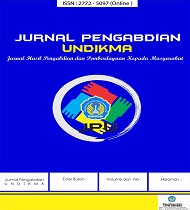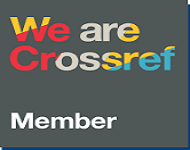Analyzing Students with Special Needs' Sense of Humor in Emerald School South Jakarta
DOI:
https://doi.org/10.33394/jk.v6i2.2315Keywords:
Children with Special Needs, Humor, Communication, Learning styles, Education.Abstract
This study collates the current state of knowledge regarding the sense of humor attitude in the social interactions among children with special needs, which aims to explore the current state of knowledge and quality of empirical evidence relating to humor among children with special needs. In the study there were involved 78 students of Emerald School of Cinere in South Jakarta. There were more over 20% students in normal condition and students with special needs were 80%. Research had assessed humor in the classroom and humor expression in different groups including those with autism, down syndrome, and other special needs. This study was designed by using the descriptive qualitative method to analyze, describe, and explain the data. The procedure of data collection was done by observation and filled the questionnaire of the Richmond Humor Assessment Instrument (RHAI). The result of the study showed that there were 47, 08% of favorable criteria, and 52, 92% of unfavorable ones. Based on gender, more boys answered favorable criteria compared to girls. Moreover, boys were dare to express their senses of humor than the girls. The girls showed their shynesses to express their sense of humor. The results of the study showed that the children with special needs in Emerald school had less sense of humor. Furthermore, the role of humor in communication development, social facilitation, creativity, and stigma had all received some limited attention among children with special needs in Emerald School, South Jakarta.
References
Andriyani, Y. (2016). an Analysis of Teachers ’ Humor Use in Efl Classroom.
Bolkan, S., Griffin, D. J., & Goodboy, A. K. (2018). Humor in the classroom: the effects of integrated humor on student learning. Communication Education, 67(2), 144–164. https://doi.org/10.1080/03634523.2017.1413199
Chadwick, D. D., & Platt, T. (2018). Investigating humor in social interaction in people with intellectual disabilities: A systematic review of the literature. Frontiers in Psychology, 9(SEP), 1–16. https://doi.org/10.3389/fpsyg.2018.01745
Cornett, C. E. (1986). Learning Through Laughter: Humor in the Classroom, 45. https://doi.org/86-61756
Educational Bureau The Government of Hongkong Administrative Region. (2007). How to Identify Children with Special Needs.
Gnevek, O., Musijchuk, M., & Musiichuk, S. (2018). Humor as a means for developing student creativity. Espacios, 39(40).
Hornby, G. (2015). Inclusive special education: Development of a new theory for the education of children with special educational needs and disabilities. British Journal of Special Education, 42(3), 234–256. https://doi.org/10.1111/1467-8578.12101
Hussu, A. M., & Strle, M. (2010). The assessment of children with special needs. Procedia - Social and Behavioral Sciences, 2(2), 5281–5284. https://doi.org/10.1016/j.sbspro.2010.03.861
Mora, R. A., Weaver, S., & Mae Lindo, L. (2015). Editorial for special issue on education and humour: Education and humour as tools for social awareness and critical consciousness in contemporary classrooms. European Journal of Humour Research, 3(4), 1–8. https://doi.org/10.7592/ejhr2015.3.4.mora
Motlagh, F. G., Motallebzade, K., & Fatemi, M. A. (2014). On the effects of teacher’s sense of humor on Iranian’s EFL learners’ reading comprehension ability. International Journal of Applied Linguistics and English Literature, 3(4), 1–5. https://doi.org/10.7575/aiac.ijalel.v.3n.4p.1
NCSE. (2014). Children with special educational needs, information booklet for parents. National Council for Special Education, 1–68.
Pérez-Aranda, A., Hofmann, J., Feliu-Soler, A., RamÃrez-Maestre, C., Andrés-RodrÃguez, L., Ruch, W., & Luciano, J. V. (2019). Laughing away the pain: A narrative review of humour, sense of humour and pain. European Journal of Pain (United Kingdom), 23(2), 220–233. https://doi.org/10.1002/ejp.1309
Povian, C.-M., Gurza, V. G., & Dumitrescu, C. (2014). Special Education Tools, Concepts and Design for Children in Need. Procedia - Social and Behavioral Sciences, 141, 996–1002. https://doi.org/10.1016/j.sbspro.2014.05.168
Richmond, V. P. (2013). Richmond Humour Assessment Instrument (RHAI).
Semrud-Clikeman, M., & Glass, K. (2010). The relation of humor and child development: Social, adaptive, and emotional aspects. Journal of Child Neurology, 25(10), 1248–1260. https://doi.org/10.1177/0883073810373144
Wu, C. L., Tseng, L. P., An, C. P., Chen, H. C., Chan, Y. C., Shih, C. I., & Zhuo, S. L. (2014). Do individuals with autism lack a sense of humor? A study of humor comprehension, appreciation, and styles among high school students with autism. Research in Autism Spectrum Disorders, 8(10), 1386–1393. https://doi.org/10.1016/j.rasd.2014.07.006
Downloads
Published
How to Cite
Issue
Section
Citation Check
License
License and Publishing Agreement
In submitting the manuscript to the journal, the authors certify that:
- They are authorized by their co-authors to enter into these arrangements.
- The work described has not been formally published before, except in the form of an abstract or as part of a published lecture, review, thesis, or overlay journal.
- That it is not under consideration for publication elsewhere,
- That its publication has been approved by all the author(s) and by the responsible authorities tacitly or explicitly of the institutes where the work has been carried out.
- They secure the right to reproduce any material that has already been published or copyrighted elsewhere.
- They agree to the following license and publishing agreement.
Copyright
Authors who publish with JK agree to the following terms:
- Authors retain copyright and grant the journal right of first publication with the work simultaneously licensed under a Creative Commons Attribution License (CC BY-SA 4.0) that allows others to share the work with an acknowledgment of the work's authorship and initial publication in this journal.
- Authors are able to enter into separate, additional contractual arrangements for the non-exclusive distribution of the journal's published version of the work (e.g., post it to an institutional repository or publish it in a book), with an acknowledgment of its initial publication in this journal.
- Authors are permitted and encouraged to post their work online (e.g., in institutional repositories or on their website) prior to and during the submission process, as it can lead to productive exchanges, as well as earlier and greater citation of published work.
Licensing for Data Publication
-
Open Data Commons Attribution License, http://www.opendatacommons.org/licenses/by/1.0/ (default)

This work is licensed under a Creative Commons Attribution-ShareAlike 4.0 International License.







